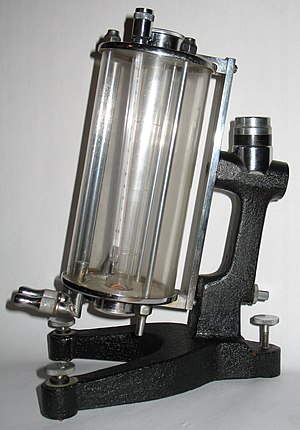Falling ball viscometer
The falling ball viscometer is a special type of viscometer and is used for the precise measurement of the viscosity of transparent Newtonian liquids and gases. It complies with the requirements specified in DIN 53015 and can be officially calibrated . In connection with a circulation thermostat, its measuring accuracy is very high. The falling ball viscometer was invented in 1932 by the chemist Fritz Höppler . Therefore this measuring device is also known under the name Höppler viscometer according to DIN 53655.
Measuring principle
A ball moves in rolling and sliding motion in an inclined cylindrical tube that is filled with the fluid to be tested. The time is measured that the ball needs to travel a defined measuring distance . By pivoting the measuring part, the return of the ball can also be used for the measurement. With the help of Stokes' law of sedimentation , the dynamic viscosity is calculated, which is given in m Pa · s (10 −3 Pa · s). The controlled rolling movement of the test ball serves to avoid turbulence in the fluid, which would otherwise arise from a freely falling ball.
For the mobile analysis of mineral oils there are simplified forms of the falling ball viscometer that allow the viscosity to be determined directly on the machine.
Applications
- Chemical industry (e.g. solutions of plastics, solvents, resin solutions, ink)
- Pharmaceutical industry (e.g. raw materials, glycerine)
- Food industry (e.g. gelatine, wort, sugar solution)
- Mineral oil industry (e.g. oils, liquid hydrocarbons)
- Large diesel engines (e.g. dilution of the lubricating oil with fuel)
- Shipping (e.g. injection temperature of heavy fuel oil)
swell
- Bauer, Frömming, Führer: Textbook of Pharmaceutical Technology
- Rudolf Voigt: Pharmaceutical Technology
Individual evidence
- ↑ p. 54
- ↑ tec-science: Experimental determination of viscosity (viscometry). In: tec-science. April 2, 2020, accessed on June 25, 2020 (German).
- ^ European Pharmacopoeia , Deutscher Apotheker Verlag Stuttgart, 6th edition, 2008, pp. 108-109, ISBN 978-3-7692-3962-1 .
